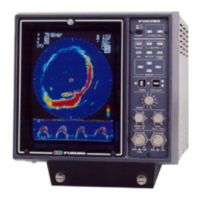
Do you have a question about the Furuno CH-24 and is the answer not in the manual?
Explains the meaning of DANGER, WARNING, and CAUTION notices in the manual.
Covers essential safety measures regarding electrical hazards, handling, and environmental factors.
Congratulatory message and overview of the sonar's features and company reputation.
Advice on keeping magnetic materials away and ensuring adequate ventilation for the unit.
Recommendations for adjusting screen brightness to protect the operator's eyes.
Identifies main operational controls like POWER, TRANSDUCER, MODE, SECTOR, TARGET LOCK, OUTPUT, DIMmer, MARKER, TILT/SHIFT, TRAIN, RANGE, GAIN/AGC, NOISE LIMiter/IR, VOL, BRIL.
Details on the functions and operation of the TRANSDUCER and MODE selection switches.
Explains the functions and adjustments for SECTOR, TRAIN, and DIMMER switches.
Details on the OUTPUT switch for power adjustment and TARGET LOCK switch for tracking.
Explains the AREA and EDGE modes for target tracking and their operational parameters.
How to use the MARKER switch to position target and zone markers on the display.
Operation of TILT/SHIFT switch for transducer angle and RANGE shift.
How to select detection range and use NOISE LIM/IR controls for interference rejection.
Comprehensive guide to adjusting GAIN, AGC, TVG, BRIL, and VOL for optimal performance.
Explains symbols and readings for Mode 1 and Mode 2 (Sonar Mode) displays.
Explains symbols and readings for Mode 3 (Vertical Sounding Mode) display.
A step-by-step guide for the typical operation of the CH-24 sonar system.
Explains how the sonar image is formed and the features of the historical echo display.
How different training modes affect the displayed sonar information and interpretation.
Describes how various seabed types, contours, and conditions appear on the sonar screen.
Visual characteristics of reefs, wrecks, and surface fish schools as displayed on the sonar.
How midwater fish schools are displayed based on tilt angle and training sector settings.
Techniques for identifying bottom fish schools, especially when near bottom echoes.
Managing unwanted signals like sea surface reflections, interference, and wakes.
Identifying and dealing with false echoes from sidelobes and various noise sources.
Visual examples of sonar readings and their interpretations in various fishing scenarios.
Guidance on adjusting the gain control for clear and accurate target detection.
How the Time Varied Gain (TVG) function improves echo strength and filters noise.
Techniques to reduce unwanted echoes from the seabed and the water surface.
Strategies for eliminating unwanted signals from onboard equipment and external sources.
Specific operational tips for purse seining using the sonar system.
Specific operational tips for bottom trawling using the sonar system.
Guidelines for maintaining and cleaning the sonar display unit.
Care instructions for transceiver and hull units, including lubrication of the hull unit.
Procedures to clean the retraction tank and remove marine growth to ensure smooth operation.
Information on when and how to replace grease cotton rings to prevent water penetration.
How to perform and interpret self-checks for the display unit's components and switches.
Procedures for verifying the functionality and response of the hull unit.
Technical specifications for the display system, color representation, and available display modes.
Detailed technical parameters for sonar range, pulselength, and data displayed on screen.
Technical details related to the transceiver, automatic training, and transducer tilt functions.
Specifications for allowable ship speed, optional functions, and power supply requirements.
Guide to customizing operating specifications using internal DIP switches.
Configuration of internal switch S3 and adjustment of transducer travel stroke.
Instructions for installing the VDO board to connect an external monitor TV.
Overview of how ultrasonic waves behave in aquatic environments to enhance fishing efficiency.
Explains how temperature, salinity, and depth influence sound speed in seawater.
Details on how sound energy is lost and bent as it propagates through water.
How air bubbles disrupt sound propagation and cause adverse effects on sonar signals.
Analysis of how different seabed types and fish schools reflect sound waves, causing reflection loss.
Examination of how reflection loss varies with frequency and specific fish species.